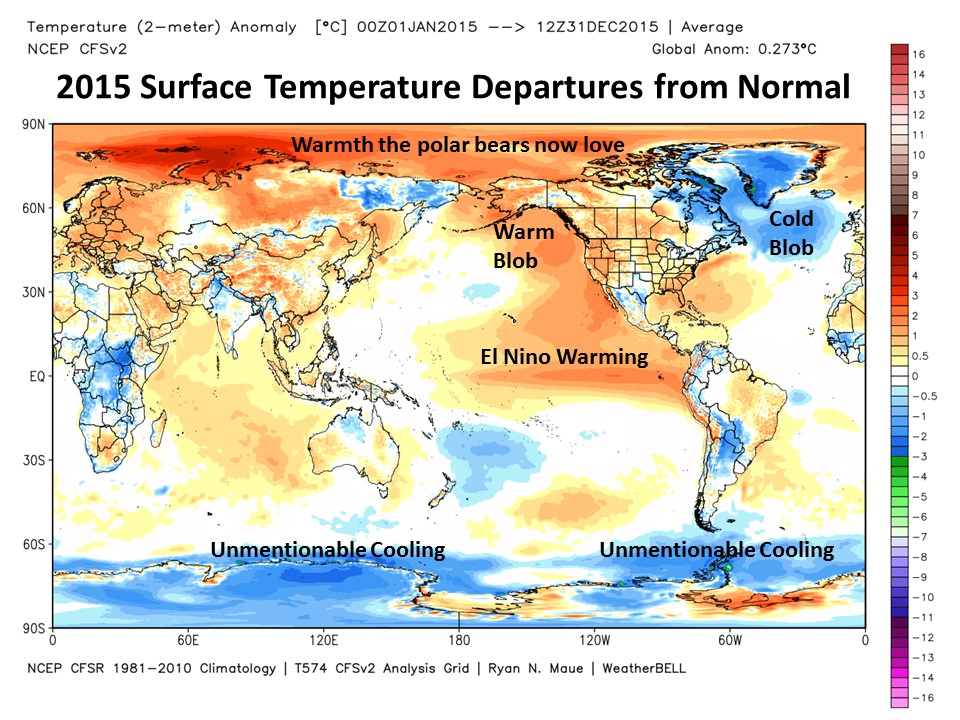
Dick Lindzen suggested to me recently that this might be a good time to address the general question, “what causes the global-average warmth during El Nino?”
Some of you might say, “the sun, of course”. Yes, the sun’s energy is the ultimate source of energy for the climate system, but it really doesn’t explain why El Nino years are unusually warm…or why La Nina years are unusually cool.
The answer lies in the circulation of the Pacific Ocean, more specifically the vertical circulation of that ocean basin.
The short answer is that, during El Nino, there is an average decrease in the vertical overturning and mixing of cold, deep ocean waters with solar-heated warm surface waters. The result is that the surface waters become warmer than average, and deeper waters become colder than average. The opposite situation occurs during La Nina.
Importantly, the change shows up in global average ocean computations, based upon ocean temperature data (see our Fig. 3, here); this means that the changes centered in the Pacific are not offset by changes of the opposite sign occurring in other ocean basins.
The Details
Most of the depth of the world’s oceans is very cold, even in the tropics. Only the near-surface layers are warm, with the rest of the ocean depths being filled up over thousands of years by surface water chilled to low temperatures at high latitudes. (This leads to the interesting observation that the mass-weighted average temperature of the climate system is actually very cold).
This average state of warm surface (due to solar heating) and cold depths is continually being offset by vertical mixing processes (wind-driven wave-induced mixing, tidal flows over bottom topography, and other processes). When these processes slow down during El Nino, surface water (mainly the upper 100 meters) become warmer than normal. At the same time, the layers below 100 meters become colder than normal (100 m is the global-average depth of this demarcation).
In a sense, the deep ocean provides an air conditioner for the climate system, and during El Nino the air conditioner isn’t working as hard to cool the atmosphere. During La Nina, it’s working harder than normal, leading to global-average coolness.
Since the atmosphere responds to surface heating, anomalous warmth in the upper ocean layers gradually heats the atmosphere, mainly through increased precipitation heating in response to large rates of evaporation from the warm surface waters. This initially occurs in the tropics where the ocean circulation change is the strongest, but then spreads to higher latitudes as well. The warming is not uniform, of course, and a few regions can even experience below normal temperatures…but in the global average, there is warming.
The plot of 2015 temperature anomalies shown above reveals there are indeed other things happening (graphic courtesy of Weatherbell.com, annotated by me). It should be mentioned that the map projection greatly exaggerates the actual size of the polar areas compared to the tropics.
Note that I have not mentioned Pacific westerly wind bursts, or propagating Kelvin waves, or reduced ocean upwelling, since these are just regional manifestations of the whole process…
In the “big picture”, the cause of El Nino warmth is still a reduction in the overall vertical mixing of warm surface waters with cold deep waters. (Reduced upwelling of cold deep water must, by mass continuity, be accompanied by decreased downwelling of warm surface water, which just means an overall reduction in vertical mixing in the ocean.)
Does El Nino Warm the Entire Climate System?
This is an interesting question that we addressed in our 2014 APJAS paper. The consensus opinion of El Nino and La Nina is that it is just a quasi-periodic oscillation of the climate system that has no long-term impact on global temperature trends.
But we demonstrated that as El Nino develops there is an increase in radiative energy input into the global-average climate system which precedes peak El Nino warmth by about 9 months. This is mostly likely due to a small decrease in low cloud cover associated with the changing atmospheric circulation patterns during El Nino (La Nina would have increased cloud cover).
Thus, if the climate system goes through a multi-decadal period of increased El Nino activity (and decreased La Nina activity), like what happened after the 1970s, there can be a multi-decadal natural warming trend that is entirely natural in origin as more solar energy is absorbed by the system. This complicates identification and quantification of the human greenhouse gas-forced portion of climate change, leading (in my opinion) to overestimates of the anthropogenic warming effect.
Now, everyone who studies the El Nino/La Nina (ENSO) phenomenon comes to a somewhat different conceptual understanding, and I might be missing some important component that others are welcome to point out. But the above represents my view as a result of our analysis of global average ocean temperature fluctuations as a function of depth since the 1950s which was part of our 2014 APJAS paper, as well as our analysis in that paper of CERES satellite radiative budget changes associated with ENSO.
Again, my emphasis is on the global-average manifestation of ENSO, which then leads to an explanation of global average warmth associated with El Nino. Regional changes involving Kelvin waves, westerly wind bursts, etc., are not sufficient to explain the net warming effects of El Nino. That instead requires (in my view) a global-average decrease in the mixing of warm surface waters and cold deep waters, as I have outlined above.

 Home/Blog
Home/Blog



